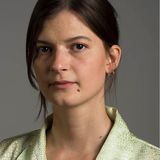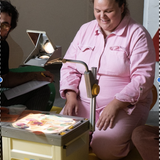In this special episode of ‘Designing Cities for All’, we delve into the neuro-inclusive theory of ‘designer by default’, which challenges traditional notions of design and creativity. Originating from lived neurodivergent experiences, the panel participants will debate on the theory and showcase concrete examples of their work that utilized a designer by default methodology. This event is designed purposely to meet various sensory needs and cater to diverse brains. Join us as we explore how embracing neurodiversity in design can lead to more innovative and inclusive environments for all.
About the speakers
François Chambard is a designer and maker. In 2004 he started UM Project (Users & Makers) at the crossroads of function and fiction for the work of a single designer/maker, yielding projects and objects, experiments and unusual goods. Recently the practice has evolved, giving birth to Unblock. Space, to encourage the work of many, colliding human technology and the spirit of things, with a particular interest in neurodiversity and its positive impact on the design process.
Laura Stachon is an interdisciplinary Designer from Germany currently living in the Netherlands. She holds a Bachelor’s degree in Jewelry Design from the Faculty of Design, Pforzheim Germany and a Master’s degree in Contextual Design from the Design Academy Eindhoven, Netherlands. In her current design practice, which intersects psychology, architecture, and sensory experience, she is captivated by the influence public spaces wield over our mood and self-esteem. Her research delves into personal experiences within high-pressure and competitive environments, such as school and work. Through her Master’s graduation project ‘Walls That Match My Mood,’ she aims to explore how these environments could transform when approaching from a shy and neurodiverse point of view.
About Designing Cities for All: RE generation
Over the past two years of Designing Cities for All (DCFA) we’ve learned about exclusion by design and the (re)-design of inclusive cities. Along the journey, a certain question kept popping up: what exactly does ‘for all’ entail? After focusing mostly on the ‘who’ over the past two years, DCFA is rebooting as Designing Cities for All: RE-generation . This time around, the series is also incorporating the ‘what’ by looking through the fresh lens of regenerative design . This emerging field might very well be a promising answer to the challenges of our time, as it focuses on the (re)-design of products, services, and ecological recovery that keeps the systems healthy.


We are living in a time of increased neurodiversity and awareness about ADHD, Dyslexia, Autism, and others neurological states. In fact, one in eight people are considered neurodiverse but fewer than 50 percent know it. Neurodivergents tend to be high energy, out of the box thinkers, excel in a crisis, and be bold problem solvers, but navigating the modern workplace can be a challenge. Not only is designing space to be inclusive the right thing to do, there is a compelling business case for it as well. Space today needs to reflect the diverse makeup of organizations to set all up for success.

A defensive strategy for our symbols might insulate progressive campaigns from co-opting by the right.

This is the Content Strategy Insights podcast, episode number 115. Research shows that at least 20% of the population exhibits one or more of these types of neurodivergence. If you’re a human-centered design practitioner, you don’t want to overlook this important group of humans. To learn more, listen in on this conversation with Katrin Suetterlin, a content architect and an expert on designing for neurodivergent populations.

True inclusivity in design transcends the myth of the 'standard'. When we aim to cater only to the 'norm', we miss out on the richness of diversity. By crafting spaces that consider neurodiversity and a range of physical abilities, we create an environment that benefits everyone, enhancing comfort, productivity, and well-being.











